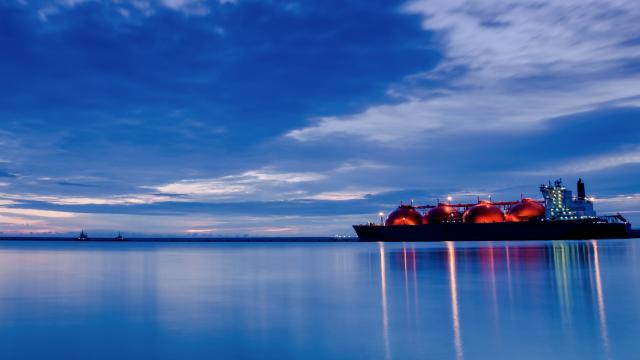
U.S. LNG exports could be a long-term support for natural gas producers and entities up and down the value stream but achieving that potential rests on lots of factors in this complicated business:
- International prices that compete with U.S. exports;
- Financing of huge facilities;
- Long-term commitments from buyers to support financing and guarantee ROI; and more.
Recent reports from Bernstein Research and Tudor, Pickering, Holt & Co. analyzed the U.S. market and what economics and commodity prices it will take to achieve acceptable returns.
Analysts at Bernstein led by Jean Ann Salisbury keyed in on the economics of fixed fees, specifically, “several upstart LNG projects (that) have advertised costs of $500/ton and $2/MMBtu fixed fee (as compared to the Wave 1 range of $2.25-$3.50/MMBtu.” Promised costs such as these have attracted significant attention, because if they are possible, “it could lock in structurally low LNG costs for decades,” Salisbury and co-authors noted, and undercut the economics of early movers in the space like Cheniere Energy Inc. To gain insight, the Bernstein analysts analyzed three ventures: Calcasieu-Venture; Driftwood-Tellurian and Magnolia LNG.
New technologies adopted by companies jumping into the game are driving the promised lower fixed costs. But the analysts found in their “deeper dive” that most are “within the range of costs for existing U.S. brownfield buildouts, including Cheniere,” and further, the technologies put forward “remain untested at the scales in which they are being touted.”
The LNG capex numbers put forward often don’t include capital outlays for pipelines, pre-construction, power plants and other factors. Additionally, they point out, competitors could employ the same new technologies, pressuring prices for all.
“In general, though, even with the decline in the cost of LNG related to the general softness in oil and gas service costs and the application of new technologies, it seems unlikely that the overall costs of LNG are going to be below $600/ton or that $2/MMBtu prices can be achieved,” they said.
In an apples-to-apples comparison with Cheniere’s operations, they figure that the new ventures could not make a 10% return at less than $2.25/MMBtu. “This gives us confidence that the next train to FID will have at least a $2.25/MMBtu tariff (which would still only give a 10% IRR, meaning the delivered cost of U.S. LNG to Asia should remain in the $7-$8/MMBtu range.”
Less positive, the analysts noted, is the possibility that the new ventures would settle for a 10% IRR “versus the 13% to 18% IRR that Chenier achieved in previous trains.” This and other factors could lead to a cap on the spot market price even post-2022, they noted.
Tudor, Pickering, Holt & Co. also issued a comprehensive outlook on the U.S. LNG industry. The analysts led by managing directors Anish Kapadia and Matt Portillo concurred that only a small proportion of the potential LNG export capacity will materialize.
“We see risk to projects primarily from the inability to secure buyers (little signed YTD), related to this the ability to finance projects and also see risk of timing delays from permitting delays. We will also need upwards of $3/MMBtu Henry Hub to incentivize production,” they said.
U.S. LNG suppliers will face stiff competition from projects outside the U.S. competing for the same set of buyers. “As a result, we think that spot LNG prices will remain in single digits well into the 2020s,” the TPH analysts said.
Upstream gas producers could see upside, as “U.S. gas potentially gets tight post-2020.” The midstream also will need to step in to provide incremental pipeline capacity in primary basins like the Permian and the Northeast. “Gas price will need to facilitate greenfield capacity that will come in well above historical tariff rates.”
Recommended Reading
Utica Oil Riches’ Biggest Challenge: Moving the Crude
2024-10-28 - Leslie Armentrout, the president and co-founder of Silver Cross Energy Partners discusses the opportunities of the Central Basin Platform and Utica—and the challenges.
Moss Lake Picks Wood to Design DeLa Express NatGas Project
2024-09-16 - Moss Lake Partners has selected British engineering firm Wood to design the 645-mile DeLa Express pipeline.
Marubeni Acquires 50% Stake in Ozona’s Eagle Ford CCS Project
2024-09-25 - Japanese oil and gas producer Marubeni Corp. has acquired a 50% stake in Ozona CCS’ Eagle Ford Shale project in the Hawkville Field.
PEDEVCO Teams Up with Denver E&P To Develop D-J Basin Acreage
2024-10-01 - PEDEVCO is teaming up with a private equity-backed Colorado operator to jointly develop the SW Pony Prospect in Weld County, Colorado.
Dorchester Minerals Closes M&A in Midland, Delaware, D-J
2024-10-01 - Limited partnership Dorchester Minerals closed two transactions in the Permian Basin and in Colorado’s Denver-Julesburg (D-J) Basin.
Comments
Add new comment
This conversation is moderated according to Hart Energy community rules. Please read the rules before joining the discussion. If you’re experiencing any technical problems, please contact our customer care team.






